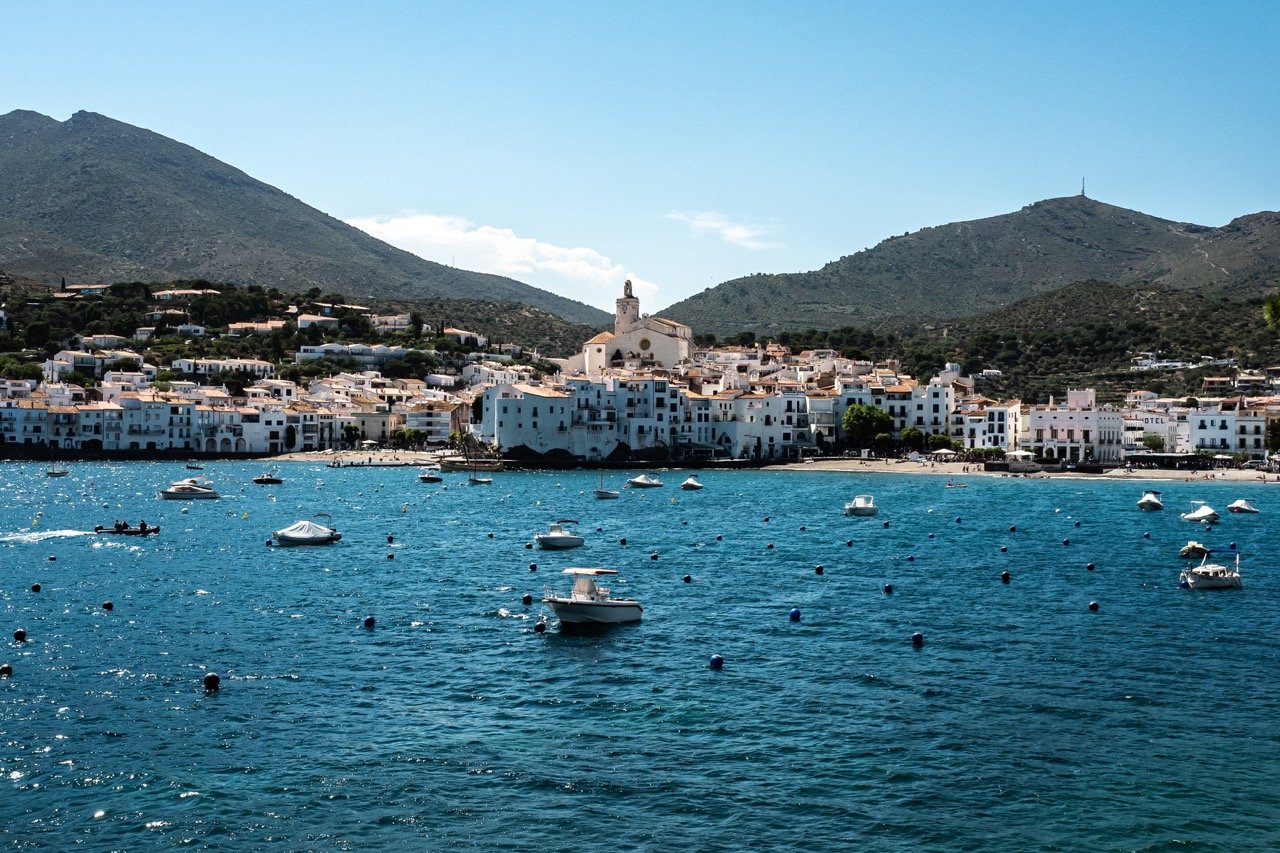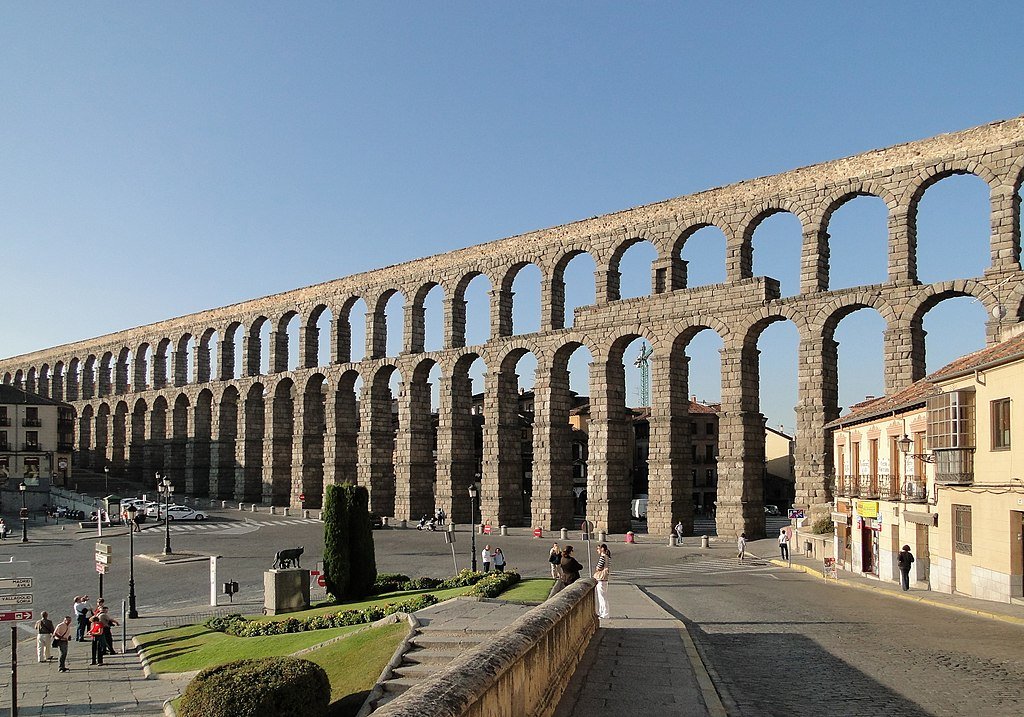Travel Guide to Segovia, Spain
Affiliate disclosure: some of the links in this article are affiliate links. If you book using one of them, we’ll earn a small commission. All of our info is free to read and free of ads, so we appreciate it!
Nestled amidst the rolling foothills of the mountains that separate the Metropolitan area of Madrid with Castile y Leon, Segovia is one of Spain’s most tempting destinations. Easily accessible from the capital, the drop-dead-gorgeous city packs a serious punch when it comes to history and architecture.
The finest aqueduct in Europe cuts through the city, drawing fascinated travelers the world over. Then there’s the city’s imposing Alcazar, fortified walls, and the behemoth Gothic Cathedral.
Said to have been founded by Hercules himself, this city is the stuff of legends. Amidst the warm terracotta and sandstone hues of the historic center, you’ll easily fall under this city’s spell. Cobbled streets, chatter wafting out of cafés and restaurants, and the distant pealing of a cathedral’s bells all serve to vault you back in time.
More Spain travel info:
For more info on travel in Spain, check out our 2-week Spain itinerary and this article on how to plan a trip to Spain.
And if you could use some one-on-one help planning your itinerary, schedule a Spain travel consultation with one of our Local Experts!
Table of Contents
Why visit?
Where is Segovia
How to get there
How long to spend
Things to see & do
How to spend a day in Segovia


Why visit?
Segovia is simply one of Spain’s most remarkable places to visit if you’re in any way a fan of architecture and history. Even if you’re not, the Roman Aqueduct and Segovia Alcazar might convert you. The city’s strategic location has made it a focal point for Spanish history, with cultural tidbits left behind by all who spent time here, from the Romans and Moors to the Catholic Kings.
All the history on show also gives the place a distinctive timeless air. It’s odd to see local life play out in the shadow of such grandeur but play out it does. Segovia’s locals are proud people, and friendly too, with a love for red wine and tapas, and of course the local specialty, roasted suckling pig.
Cobblestone alleys leading to sun-drenched plazas, people rushing to work underneath the remarkable aqueduct, café chatter mixing with the distant peal of cathedral bells; Segovia is a place that immediately makes you feel lost in time.
But most of all, you should visit Segovia simply for its trio of incredible sights: The Roman Aqueduct, the intimidating Alcazar, and its behemoth Cathedral. Any of them alone would put a city on the map; Segovia has all three.
Where is Segovia?
Segovia enjoys a strategically important location on Spain’s central plains, which are mostly made up by the autonomous community of Castile y Leon. The city sits just 60 miles from Madrid, but don’t let the proximity to Spain’s buzzing capital fool you; Segovia is a world unto itself.
Guarding one edge of the Sierra de Guadarrama mountains, the natural barrier between Madrid and Castile y Leon, Segovia is a UNESCO-listed city filled with some of Spain’s most inspiring historic architecture.
Thanks to its proximity to the Sierra de Guadarrama Mountain range, Segovia is a surprisingly fertile place when compared to the rest of Castile y Leon, which is known for being arid, dry, and dusty.
Surrounding Segovia is a patchwork of pine-clad hills and valleys, with winding rivers making their way down from the mountains. This in turn means that the city is surrounded by farms and vineyards, which slowly fade away the further north you go.

Connect with one of our Spain-based local experts for help perfecting your itinerary, answers to all your travel questions, and fabulous local tips!
How to get here
Arriving by train
Segovia is easily accessible from Madrid, Spain’s capital city. High-speed trains make the journey a breeze, taking a mere 27 minutes to arrive at Segovia from Madrid’s Chamartín station. It’s quick and comfortable, with almost 30 departures a day and tickets costing approximately between €14 and €30.
You can book directly with RENFE, Spain’s national rail carrier.
Arriving by bus
Buses are also a convenient option, taking around 1 hour and 20 minutes to make the journey, with frequent departures throughout the day, every 15 to 45 minutes or so.
Tickets cost between €7 and €10 per person, so while slower than the train, they’re much cheaper.
Renting a car
Because public transport is so good (and much faster than driving), there’s no reason to ever take a car if you’re doing a day trip from Madrid. However, if you’re leaving Madrid behind and departing on a road trip, with Segovia as one of your stops, then driving of course makes sense.
Segovia is just over an hour from Madrid, and you’ll head out of the city to the northwest on the excellent A6 highway for most of the drive.
DiscoverCars is an online aggregator that includes offerings from all the major international rental companies as well as lots of smaller local agencies, which often have much better pricing. If you plan on renting a car, I always recommend checking prices on it as you can frequently find great deals.
AutoEurope is another aggregator that I really like. It tends to be more expensive, but they only list options from large, well-reviewed companies and their customer service is excellent. Their deals often include “zero deductible” rental insurance and they’re the best option if want the easiest experience and are ok paying a little more for it.
How long to spend in Segovia
You only need a full day to see the main sights in Segovia, but I recommend staying overnight, as the atmosphere here is really special in the evening. During the day, the city fills up with day-trippers pouring in from Madrid, which gives it a lively energy, but at times, a fair deal of crowds.
However, most visitors leave by late afternoon or early evening, and as Segovia empties out and quiets down, you’ll feel like you’ve got it all to yourself. Walking through its maze of streets and marveling at the incredible architecture here with almost no one else around is genuinely wonderful.
So, if you have a full day in Segovia, here’s how I’d recommend spending it: in the morning, you’ll have time to visit the Roman Aqueduct and the city’s historic center, including a guided tour of the Segovia Cathedral. As the day moves into afternoon, you can visit one of the city’s museums, tour the incredible Alcazar, and then watch the sunset from a section of the old city walls.
In the evening, wander around the town, grab dinner, hop in to a bar or two, and just enjoy the spectacular surroundings.
Where to stay in the city
For overnight stays, history buffs can’t miss the chance to stay at the pricey Hotel San Antonio El Real, a 15th century monastery-turned hotel with modern rooms and a fantastic restaurant for dinner.
In the historic core, Hotel Real Segovia is an all-round solid choice for location, comfort, and nice views over a central plaza.
Both hotels cost approximately $100 USD per night.

What to see & do
1. The Roman aqueduct
The Roman Aqueduct of Segovia is a masterpiece of ancient engineering and a testament to the ingenuity of the Roman Empire. Constructed in the 1st century CE, possibly during the reigns of Emperors Vespasian and Trajan, this monumental structure was designed to transport water from the Frío River across 15 kilometers to the city.
Remarkably, the aqueduct was assembled without mortar, relying solely on the precise balance of forces between its 20,400 granite blocks. Climb the stairs behind the city’s main tourist office to reach the Mirador del Aqueduct, an unparalleled vantage point to view this ancient masterpiece.
The aqueduct. Photo: Bernard Gagnon, CC BY-SA 3.0, via Wikimedia Commons
2. The Alcazar
Perched on a rocky outcrop near the Guadarrama Mountains, the Alcazar of Segovia seems as if it has been lifted straight out of a fairytale. But really, it’s the other way around; rumor has it that this stunning castle inspired Walt Disney’s Cinderella Castle.
Originally built by the Romans to protect the surrounding area, the Alcazar has served both as a military stronghold and a royal residence, undergone reconstruction in the medieval era, and witnessed countless historic events.
Today, all that history is on display inside the Alcazar Museum, as are stunning views over Segovia and the surrounding countryside.
The Alcázar of Segovia. Photo: Alcázar of Segovia , CC BY-SA 4.0, via Wikimedia Commons
3. Segovia Cathedral
Located in the heart of Segovia's old city center, Segovia Cathedral is a masterpiece of Gothic architecture. As the last Gothic cathedral built in Spain, the grand exterior showcases exquisite craftsmanship and intricate details – the culmination of centuries’ worth of architectural learnings and around 200 years of construction.
Inside are all the usual trappings of a Spanish cathedral: ornate chapels, beautiful tapestries and artworks, and stained-glass windows letting in a soft light over it all. Join one of the guided tours to be able to climb the bell tower, rewarding you with great views of the city.
With your entrance ticket to the cathedral, you’ll also be granted admission into the nearby Palacio Episcopal, just a 3-minute walk from Plaza Mayor. This beautiful building served as the former residence of local bishops until the end of the 20th century, and now is filled with artworks, sculptures, and religious artefacts.
Segovia’s Cathedral. Photo: Carlos Delgado, CC BY-SA 3.0, via Wikimedia Commons
4. Exploring the city’s walls
The Alcazar wasn’t the only defensive structure protecting Segovia; it also was encircled by a protective wall. Dating back to the 2nd century, the walls were first built by the Romans, and then later reinforced after the Christian reconquest booted the Moors out of the city.
Along the top of the ramparts, you’ll be treated to great views of the Alcazar and the Cathedral and get to visit several impressive gates such as Puerto de Santiago and Puerto de San Andres, which served as entry points to the city during medieval times.
Photo: Carlos Delgado, CC BY-SA 3.0, via Wikimedia Commons
5. The Jewish Quarter
The southern part of Segovia’s center is the old Jewish Quarter, and area in which the city’s Jewish population were confined during the late 15th century after the Catholic Monarchs came to power.
Today, you can explore the Jewish history at an interpretation center and museum (Centro Didáctico de la Judería de Segovia), occupying the 15th century home of one of the most important members of the Jewish community, Abraham Seneor.
6. Feast on roast suckling pig
Segovia has a lot of specialties on the menu. Being so close to the mountains, where snow falls in the winter, means that a lot of the best food is warm and hearty; think rich stews, sausages, and roasted meat.
But the signature dish of Segovia must be the roast suckling pig, so tender that they can cut it with the edge of a plate in the restaurants (which they do when serving).
7. Plaza Mayor: the heart of the city
Plaza Mayor is the vibrant central square of Segovia, a busy spot that’s lined with shops, cafés, and restaurants. If you’re looking for a scenic place to sit outside on a terrace with a drink and a bite to eat with views of the Segovia Cathedral, this is your best bet.
The Plaza Mayor. Photo: Sergey Ashmarin, CC BY-SA 3.0, via Wikimedia Commons
8. Iglesia de Vera Cruz
Nestled on a verdant slope near la Pradera de San Marcos, the Iglesia de la Vera Cruz stands as a testament to Segovia’s rich Romanesque heritage. Consecrated in 1208, this architectural gem was erected by the Knights Templar, echoing the design of Jerusalem’s ancient Church of the Holy Sepulcher. Each of its twelve sides represents an apostle, encircling a central nave.
The interior is adorned with the emblems of the Order of Malt and a unique two-level chamber within the nave, where the Templars’ mysterious ceremonies were conducted.
Iglesia de la Vera Cruz. Photo: AdriPozuelo, CC BY-SA 3.0 ES, via Wikimedia Commons
9. Royal Palace of La Granja of San Ildefonso
Located in the hills near Segovia, the Royal Palace of La Granja of San Ildefonso is a magnificent 18th-century palace that offers a glimpse into the opulent lifestyle of Spanish royalty.
Built as a summer residence for the Bourbon kings, this palace boasts beautifully decorated rooms and stunning gardens adorned with fountains, statues, and lush greenery.
The Royal Palace of La Granja of San Ildefonso Photo: Sanva1959, CC BY-SA 3.0 ES, via Wikimedia Commons
10. Mirador de la Pradera de San Marcos
For breathtaking views of Segovia and its most iconic landmarks, head to Mirador de la Pradera de San Marcos. This grassy viewpoint west of the Alcazar offers a panoramic vista of the medieval castle and is a great spot to catch the sunset.
11. Museum of Contemporary Art Esteban Vicente
Art enthusiasts shouldn't miss the opportunity to visit the Museum of Contemporary Art Esteban Vicente. Housed in a 15th-century palace, this museum features a variety of exhibitions showcasing contemporary artwork.
The museum's permanent collection includes works donated by the renowned painter Esteban Vicente and his wife, Harriet G. Vicente.
12. Museo Real Casa de la Moneda
Founded by Felipe II, this former royal mint played a crucial role in currency production from 1586 to 1869. This is considered among Spain’s oldest industrial facilities, and the museum offers a glimpse into Renaissance technology with the same machinery that once minted coins with rollers.
The mint was powered by the Eresma River, and today, visitors can witness the water wheel in action.

Our local experts have answers!
Connect with our Spain-based experts for help perfecting your itinerary, fabulous local tips, and expert advice on your trip planning!
How to spend a day in Segovia
Assuming you’ll begin your journey here in Madrid, either jump on a train or catch the bus up to Segovia (trains are faster, but more expensive). From the train station, you’ll want to immediately make your way to the Roman Aqueduct, climbing the stairs behind the tourist office for some exceptional views.
Then, dive into the old town, making your way to the large Gothic Cathedral. Take in the views from the roof before heading back down to find some lunch.
For lunch, you’ll want to while away an hour or two at Restaurante José María, one of the best spots in town to try the roasted suckling pig.
Then choose between visiting one of the museums (the Museo Real Casa de la Moneda gets my vote) or Romanesque churches.
Whichever option you choose, next up is the extremely impressive Alcazar, which will probably take you a couple of hours to explore.
As the afternoon fades into evening, either make the 15–20-minute walk out to the Mirador de la Pradera de San Marcos for views of the castle or jump up on the ramparts along the city walls at the southwestern corner.
Then, grab a table at Mesón De Cándido near the aqueduct for more local cuisine in a cozy tavern-style room with pictures of all the famous celebrities who have visited over the years.
Either stay overnight in the city or catch one the later trains back to Madrid.





Connect with a Spain expert
















